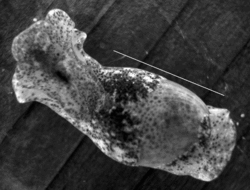Biology:Haminoea japonica
From HandWiki
Short description: Species of gastropod
| Haminoea japonica | |
|---|---|

| |
| A live individual of Haminoea japonica, head end at the upper left, scale bar 11 mm | |
| Scientific classification | |
| Domain: | Eukaryota |
| Kingdom: | Animalia |
| Phylum: | Mollusca |
| Class: | Gastropoda |
| Subclass: | Heterobranchia |
| Order: | Cephalaspidea |
| Family: | Haminoeidae |
| Genus: | Haminoea |
| Species: | H. japonica
|
| Binomial name | |
| Haminoea japonica Pilsbry, 1895
| |
| Synonyms[1] | |
|
Haminoea callidegenita (Gibson & Chia, 1989) | |
Haminoea japonica, common name the Japanese bubble snail, is a species of sea snail or bubble snail, a marine opisthobranch gastropod mollusc in the family Haminoeidae, one of the families of bubble snails.
Distribution
The distribution of Haminoea japonica includes:
- Japan[2][3]
- Korea [2]
- Hong Kong [3]
- The Philippines [2]
- Thailand
- Mediterranean Sea including Sète and Étang de Berre, France[1]
- California and Washington (state) , USA[4]
- Southern British Columbia, Canada
- Taiwan
- Netherlands (incl. Zeeland)
Description
Their shells have length around 11 mm and width around 8 mm.[5]
Parasites
The parasites of Haminoea japonica include an avian schistosome, which has been implicated in human cercarial dermatitis in San Francisco Bay, California.[4]
References
- ↑ 1.0 1.1 Gofas, S. (2009). Haminoea japonica Pilsbry, 1895. In: Bouchet, P.; Gofas, S.; Rosenberg, G. (2009) World Marine Mollusca database. Accessed through: World Register of Marine Species at http://www.marinespecies.org/aphia.php?p=taxdetails&id=238369 on 2010-09-14
- ↑ 2.0 2.1 2.2 中国科学院动物研究所. "Haloa rotundata (A. Adams, 1850)" (in zh-hans). 《中国动物物种编目数据库》. 中国科学院微生物研究所. Archived from the original on 2016-03-05. https://web.archive.org/web/20160305015748/http://www.bioinfo.cn/db05/BjdwSpecies.php?action=view&id=10555. Retrieved 2017-11-11.
- ↑ 3.0 3.1 Fofonoff, PW; Ruiz, GM; Steves, B; Simkanin, C; Carlton, JT (2017). "Haminoea japonica" (in en). National Exotic Marine and Estuarine Species Information System. https://invasions.si.edu/nemesis/calnemo/SpeciesSummary.jsp?TSN=567649. Retrieved 2017-11-11.
- ↑ 4.0 4.1 Brant S. V., Cohen A. N., James D., Hui L., Hom A. & Loker E. S. (2010) "Cercarial dermatitis transmitted by exotic marine snail". Emerging Infectious Diseases 16(9): 1357-1365. doi:10.3201/eid1609.091664 HTM, PDF.
- ↑ "Haminoea japonica" (in zh-hans). Fauna of China. http://zgdwz.lifescience.com.cn/info/101094.
Further reading
- Gosliner T. M. & Behrens D. W. (2006). "Anatomy of an invasion: systematics and distribution of the introduced opisthobranch snail, Haminoea japonica Pilsbry, 1895 (Gastropoda: Opisthobranchia: Haminoeidae)". Proceedings of the California Academy of Sciences 57: 1003–1010.
- Hanson D., Cooke S., Hirano Y., Malaquias M.A. E., Crocetta F. & Valdés Á. (2013) "Slipping through the Cracks: The Taxonomic Impediment Conceals the Origin and Dispersal of Haminoea japonica, an Invasive Species with Impacts to Human Health". PLoS ONE 8(10): e77457. doi:10.1371/journal.pone.0077457
Wikidata ☰ Q3172656 entry

